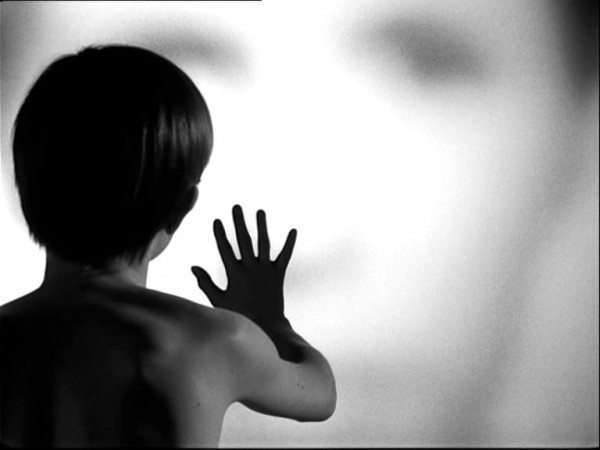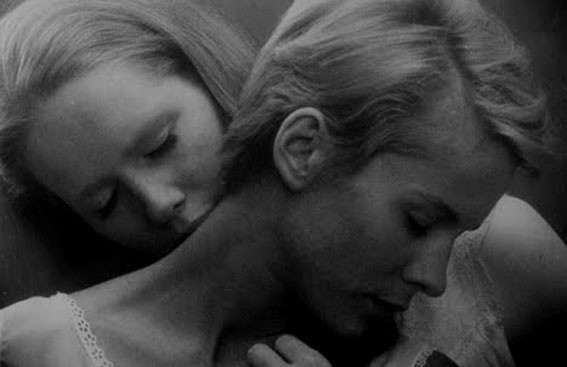PERSONA (Ingmar Bergman, 1966)
Museum of the Moving Image
35th Ave. at 36th St., Astoria
Sunday, December 29, free with museum admission, 2:30
718-777-6800
www.movingimage.us
 Ingmar Bergman’s magnificently complex 1966 avant-garde masterpiece, Persona, is not just about the relationship between an actress who has suddenly decided to stop speaking and the young nurse caring for her but about the very power of film as a narrative device able to explore and examine the psychological behavior of characters both fictional and real. Persona opens with mysterious, penetrating music by Lars Johan Werle joined by the sound and image of a movie projector as the reel counts down from ten, featuring snippets of an erect male member, a cartoon, a child’s hands, a comedic silent ghost story, a tarantula, a bleeding slaughtered lamb, and a nail being hammered through a man’s palm before the camera takes viewers inside a hospital where a boy in a bed (Jörgen Lindström) starts reading Mikhail Lermontov’s mid-nineteenth-century book A Hero of Our Time, which the author describes as “a portrait, but not of one man only. . . . You will tell me, as you have told me before, that no man can be so bad as this; and my reply will be: ‘If you believe that such persons as the villains of tragedy and romance could exist in real life, why can you not believe in the reality of Pechorin?’ . . . Is it not because there is more truth in it than may be altogether palatable to you?” That passage relates to Bergman’s oeuvre as a whole but particularly to Persona, a film about identity, storytelling, and the medium itself.
Ingmar Bergman’s magnificently complex 1966 avant-garde masterpiece, Persona, is not just about the relationship between an actress who has suddenly decided to stop speaking and the young nurse caring for her but about the very power of film as a narrative device able to explore and examine the psychological behavior of characters both fictional and real. Persona opens with mysterious, penetrating music by Lars Johan Werle joined by the sound and image of a movie projector as the reel counts down from ten, featuring snippets of an erect male member, a cartoon, a child’s hands, a comedic silent ghost story, a tarantula, a bleeding slaughtered lamb, and a nail being hammered through a man’s palm before the camera takes viewers inside a hospital where a boy in a bed (Jörgen Lindström) starts reading Mikhail Lermontov’s mid-nineteenth-century book A Hero of Our Time, which the author describes as “a portrait, but not of one man only. . . . You will tell me, as you have told me before, that no man can be so bad as this; and my reply will be: ‘If you believe that such persons as the villains of tragedy and romance could exist in real life, why can you not believe in the reality of Pechorin?’ . . . Is it not because there is more truth in it than may be altogether palatable to you?” That passage relates to Bergman’s oeuvre as a whole but particularly to Persona, a film about identity, storytelling, and the medium itself.

A young boy reaches out in avant-garde Bergman masterpiece, spectacularly photographed by Sven Nykvist
Bergman muse Liv Ullmann stars as Elisabet Vogler, an actress who suddenly stops talking while onstage in the midst of a play and continues her silence as she is hospitalized in an institution. Her doctor (Margaretha Krook) is sure there is nothing seriously wrong with Elisabet, that her refraining from speech is a choice based on the horrors she sees in the world. “Reality is diabolical,” she tells her, before sending Elisabeth and Nurse Alma (Bibi Andersson) to her cottage on Fårö Island, hoping the isolation will help ease her fears. On the island, Alma opens up about her own life, particularly about sex, but as the two women grow extremely close, they are also torn apart, both by the narrative and the celluloid, which rips and burns halfway through, setting up a chilling conclusion that is part existential thriller, part ghost story, and very much a sharp, incisive look deep into the human psyche. Filmed in haunting black-and-white by Sven Nykvist and including numerous dazzling, experimental shots, Persona is a grand cinematic achievement, an intense work that expanded the boundaries of what the medium can do. In his 1990 book, Images: My Life in Film, Bergman wrote, “Today I feel that in Persona — and later in Cries and Whispers — I had gone as far as I could go. And that in these two instances, when working in total freedom, I touched wordless secrets that only the cinema can discover.” Indeed, “wordless secrets” abound in Persona, one of Bergman’s most penetrating and mesmerizing tales. Even the title holds additional meaning, as “persona,” in Latin, originally referred to the mask an actor wore that represented the character they were playing onstage. Persona is screening December 28 at 6:00 as part of the Museum of the Moving Image series “See It Big! Great Cinematographers,” which continues at 4:30 with David Lean’s 1965 epic, Doctor Zhivago, photographed by Freddie Young.
